

| Part I. | THE REVISION OF THE “ODA CHARTER” AND JAPAN’S NEW APPROACH |
Summary
Chapter 1 gives an overview of the present situation of Japan’s official development assistance (ODA) and explains the background to and developments leading up to the revision of the ODA Charter, and the main points of the revised ODA Charter.
Japan has contributed to the development of developing countries as one of the largest donor countries in the world, but because of the severe economic and fiscal situation in Japan, the critical view of ODA held by the Japanese people, etc. in recent years, the ODA budget is in decline. Japan’s ODA in 2002 came to $9.283 billion, a 5.7% decrease from the previous year. In this context, the government is vigorously promoting ODA reform with the keywords of transparency, efficiency, and public participation.
Changes to the situation surrounding ODA are not only domestic. The advancement of globalization has brought about growth in the world economy and has raised living standards, but on the other hand, countries and regions exist that cannot receive the benefits of globalization and in which poverty is worsening. Through the 1995 World Summit for Social Development, the 1996 adoption of the Development Assistance Committee’s (DAC) “Shaping the 21st Century: The Contribution of Development Cooperation” and other things, poverty reduction became recognized as an important issue in the international community and new development issues and approaches were born: “peace-building” to respond to the regional and domestic conflicts that have frequently broken out since the end of the Cold War, and “human security” which pays attention to each individual person and aims for the protection and empowerment of people in order to ensure their survival, livelihood, and dignity.
Subsequently, the Millennium Development Goals (MDGs) which stipulated clear quantitative targets and deadlines for achievement were adopted by the international community and currently efforts toward realizing those goals are being strengthened. Since the terrorist attacks in the United States (US), the developed countries have announced increases in ODA one after the other, with the awareness that countries suffering from poverty and with weak governance can become hotbeds of terrorism. Furthermore, aid-related entities such as non governmental organizations (NGOs), local authorities, universities, research institutes and private companies and aid modalities based on aid coordination the field are becoming more diversified.
Taking into account these changes in the domestic and international situations, the government revised the ODA Charter by a Cabinet adoption on August 29, 2003 in order to achieve flexible and strategic utilization of ODA and to increase its efficiency. Given that the objective of ODA is defined to be “to contribute to the peace and development of the international community, and thereby to help ensure Japan’s own security and prosperity,” more strategic utilization of ODA is required. It is also important to reflect basic policies such as assurance of the fairness of assistance, including gender equality, and the perspective of “human security” in individual ODA projects and to make active efforts toward peace building which has become a priority issue. In addition, in conformity with the results and direction of ODA reform, it is necessary for the government in its entirety to further promote formulating and implementing assistance policies in a unified and coherent manner, strengthening policy consultations with developing countries, strengthening functions of field missions, increasing public participation, etc.
The government is currently endeavoring to steadily implement the revised ODA Charter. Specifically, it is advancing the measures under the new Charter that include the following: formulation and revision of country assistance plans (Sri Lanka, Viet Nam), formulation and implementation of the Guidelines for Environmental and Social Considerations by implementing agencies, commitment of assistance for African countries and Asian countries through the holding of the Third Tokyo International Conference on African Development (TICAD III) and the Association of Southeast Asian Nations-Japan (ASEAN-Japan) Commemorative Summit, and promotion of peace-building assistance in Iraq and Afghanistan.
ODA Photo Studio 1: Overseas students visiting Japan under the Foreign Student Grant Aid Project. The photo shows the students performing an emergency drill (Photo: Japan International Cooperation Center 2004)
Key Points
Section 1
- The decline in the ODA budget due to the severe economic and fiscal situation in Japan and the critical view of ODA held by the Japanese public, etc.
- The promotion of ODA reform in order to increase the strategic value and effectiveness of ODA and to gain the understanding and support of the Japanese people.
Section 2
- Poverty reduction has become an important issue in the international community. The emergence of the new development issues and approaches such as peace-building and human security.
- The strengthening of efforts by the international community for the development issues of developing countries. Frequent announcements by developed countries of increases in ODA.
- Continued diversification of aid-related entities, including NGOs, and aid modalities based on aid coordination in the field.
Section 3
- In the revision of the ODA Charter, the aim is ODA that is integrated into the lives of the Japanese public and the views of all sectors of society are sought.
Section 4
- In conformity with the philosophy, basic policies and the principles of ODA implementation expressed in the revised ODA Charter, Japan will utilize ODA with broad public participation to contribute to the peace and development of the international community.
- Revision of the ODA Charter alone is not sufficient to complete ODA reform; reform will be implemented steadily and continuously in future.
The ODA Charter, the fundamental document of Japan’s ODA policy, was revised for the first time in 11 years on August 29, 2003. Part I describes the process through which the ODA Charter was revised, the content of the new charter, and the future directions for the implementation of Japan’s ODA policies. Chapter 1 begins with an overview of Japan’s ODA and touches on the background to and process leading up to the revision of the ODA Charter, and in Chapter 2 there is a detailed explanation of the content of the revised ODA Charter.
ODA is an acronym for Official Development Assistance. According to the international definition, ODA is cooperation through the provision of funds or technology by the government or executive agencies to contribute to the economic and social development of developing countries or to improve their welfare. Currently, Japan is providing ODA to 145 countries and regions1 of the world.
According to an announcement by the Organisation for Economic Co-operation and Development–Development Assistance Committee (OECD-DAC)2, Japan’s ODA disbursements for 2002 came to $9.283 billion3, a 5.7% decrease from the previous year, making Japan the second largest donor country among the DAC countries for two consecutive years. And the percentage of Japan’s ODA disbursements as a share of total disbursements by all the DAC countries dropped 2.9 percentage points from the previous year to 15.9%. The main factors behind these changes are the decline in Japan’s ODA budget4 due to the severe economic and fiscal situation in Japan and a decline in the dollar value due to exchange rate5 effects, but at the same time another factor in the background is that since the United Nations International Conference on Financing for Development held in Monterrey, Mexico in March 2002, the other major donor countries have greatly increased their ODA and the total value of ODA worldwide is increasing.
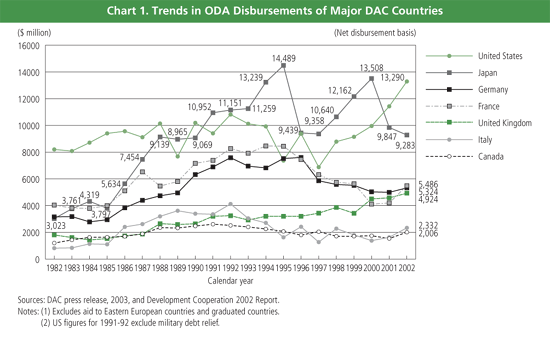 |
|
Box 1. Official Development Assistance (ODA)
|
||||||
|---|---|---|---|---|---|---|
|
The Organisation for Economic Co-operation and Development–Development Assistance Committee (OECD-DAC), a group of the major donor countries, defines ODA as funding flows that meet the following three conditions.
* Note: Grant element is an index of the financial terms of assistance, the grant element (GE) of a loan on a commercial basis (assuming an interest rate of 10% and repayment once a year) being 0%. As terms (interest rate, grace period, and maturity) are alleviated, the GE figure rises, reaching 100% in the case of a grant. |
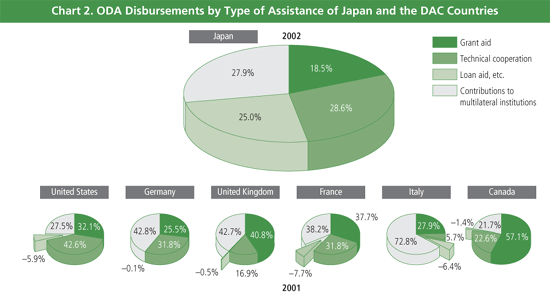 |
The percentage of ODA disbursements as a share of Gross National Income (GNI) for Japan was 0.23%, the same as the previous year, putting Japan in 18th position among all the 22 DAC countries. The per capita ODA burden for Japan was $77.4, ninth6 among DAC countries.
So in this way, Japan has contributed to the development of developing countries as one of the top donor countries in the world. The characteristics of Japan’s ODA to date include placing importance on human resources development and institution building, assistance for the self-help efforts of developing countries as the basis of assistance, a strong tendency to place importance on economic growth to maintain sustainable growth, based on Japan’s post-war reconstruction and deep ODA relations with the Asian countries due to their deep historical relations. Concerning the methods and types of assistance, the major characteristic of Japan’s ODA is that a variety of types of ODA are developed in an integrated manner. Broadly classified, these types include bilateral assistance comprising of yen loans , grant aid, and technical cooperation, as well as aid through international organizations, and aid in collaboration with NGOs.
 |
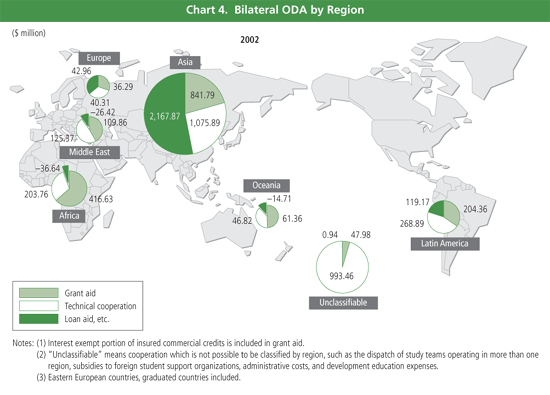 |
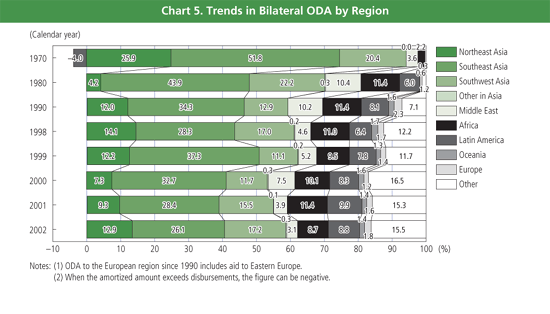 |
 |
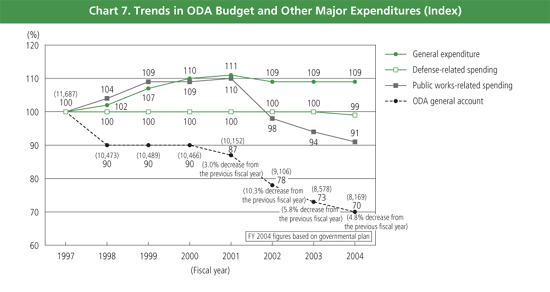 |
Since the burst of the bubble economy, Japan has been placed in a severe situation with a long-term fiscal deficit and a stagnant economy. Affected by this, the ODA budget has been declining over the last several years. From the First Medium-term Target established by the Fukuda Cabinet in 1978 to the Fifth Medium-term Target, Japan worked to quantitatively expand ODA. And in 1989, Japan surpassed the US to become the “world’s top donor of ODA” for the first time, disbursing a total of $8.96 billion. Subsequently, with the exception of 1990, Japan maintained its position as the world’s top donor of ODA for a ten-year period until 2000. However, the Japanese public’s view of ODA subsequently became stricter mainly as a result of the economic recession and public criticisms of ODA. The provisional government figures for Japan’s original ODA budget for fiscal year 2004 show a decrease of 4.8% from the previous year and the budget has been reduced by over 30% in seven years since the ODA budget peaked in fiscal year 1997. However, timely and appropriate measures were taken such as an allocation of ¥118.8 billion for reconstruction assistance to Iraq, an issue confronting the international community in the fiscal year 2003 supplementary budget.
In the diplomacy managed by Japan as a country that desires peace, ODA fulfills an important role in contributing to the peace and development of the international community and in ensuring the stability and prosperity of Japan. However, due to the decreasing budget, Japan’s ODA is currently standing at a crossroad. In order to implement ODA with the understanding of the Japanese people, it is necessary to increase the strategic value and efficiency and effectiveness of ODA. Moreover, in order to gain the understanding and support of the Japanese people for ODA, it is becoming more and more important to be accountable to the Japanese public as well as working to improve the quality of ODA. It has become a shared view that it is essential to better explain to the Japanese public that Japan’s ODA is not only functioning effectively for the development and welfare of recipient countries, but also that providing ODA is beneficial for Japan, and to increase transparency and to thoroughly enforce accountability concerning ODA.
1. This figure is for bilateral ODA only (excluding the Eastern European graduated countries). (2002 disbursements)
2. DAC is an agency of the Organisation for Economic Co-operation and Development (OECD) that primarily mediates negotiations among aid donors on quantitative increases or qualitative enhancements in aid. Established in 1961, DAC now has members from 22 developed countries, including Japan, as well as the European Commission.
3. Excluding aid for the Eastern European countries and graduated countries, and the European Bank for Reconstruction and Development
4. The ODA budget for fiscal year 2003 was 5.8% down from the previous fiscal year, the ODA budget for fiscal year 2004 is 4.8% down from fiscal year 2003; in total the ODA budget has been reduced 30.1% over the past seven years (On an original budget basis.)
5. The 2002 DAC exchange rate: one dollar = 125.20 yen (a 3.70 yen depreciation compared to 2001)
6. 2001 disbursements
ODA is financed by taxpayers’ money, so gaining popular support for and understanding of ODA is an essential precondition for its implementation. According to public opinion surveys, people have voiced many doubts about ODA in recent years, such as “why does Japan provide so much ODA?”, “Does ODA really help the people in the countries receiving it?” This can be partly attributed to the stagnation which Japan’s economy faced over the past ten years. In order to respond to these concerns of the Japanese people, the government including the Ministry of Foreign Affairs (MOFA) has been vigorously implementing ODA reform.
Minister for Foreign Affairs Yoriko Kawaguchi announced the “Ten Reform Principles to Ensure an Open Ministry of Foreign Affairs” immediately after she took up office in February 2002. One of the pillars of the reform principles is to endeavor to make ODA more efficient and transparent. Specific measures include: (1) conducting hearings of the views of NGOs at overseas diplomatic missions, (2) including third-party participants in committees to identify priority fields and projects, (3) appointing nonministry personnel to senior posts (with responsibility for evaluation) in MOFA’s Economic Cooperation Bureau, and (4) introducing proper auditing methods. The subsequent ODA reform was to be advanced based on this Ten Reform Principles.
The Second Consultative Committee on ODA Reform, inaugurated in 2001 as a private advisory body to the foreign minister and tasked with making proposals concerning how ODA should be, submitted its final report to Foreign Minister Kawaguchi in March 2002. The committee proposed concrete measures for ODA reform built around three pillars of “ODA totally utilized the mind, intellect, and vitality of the Japanese people,” “prioritized and effective ODA with a strategy,” and “drastic improvement of the ODA implementation system.” Under these measures, subsequent ODA reform was to be developed centering on the three keywords of “public participation,” “securing of transparency,” and “improvements to efficiency.”
Based on the recommendations in the final report of the Second Consultative Committee on ODA Reform, the Board on Comprehensive ODA Strategy*1 was established in June 2002. Then in July 2002, MOFA announced “Fifteen Specific Measures for ODA Reform” in the five areas of “auditing,” “evaluation,” “partnership with NGOs,” “exploring, fostering, and utilizing human resources,” and “information disclosure and publicity,” and reform was further advanced under the policy of “immediately implementing whatever possible.” Taking into account the discussions at the Board on Comprehensive ODA Strategy, Foreign Minister Kawaguchi announced “ODA Reform: Implementation of Three Measures” on December 10, 2002 and commenced a revision of the ODA Charter.
Revision of the ODA Charter was decided with the above situation in the background. Japan’s ODA policies are implemented based on a policy framework with the ODA Charter at the top. The ODA Charter was approved by a Cabinet decision in 1992 as a comprehensive compilation of Japan’s basic approach and policies regarding development assistance. The current revision resulted simply from the strong awareness that it was necessary to compile the results of ODA reforms in recent years and to reflect them in a new charter.
| Column 1 |
An Attitude Survey on Development (from the fiscal year 2003 “Opinion Survey on Foreign Policy”) |
||
|
The diagram below titled, “Japan’s Future Economic Cooperation” from the “Public Opinion Survey on Foreign Policy” (implemented since 1975) shows how the Japanese people think about ODA.
|
|||
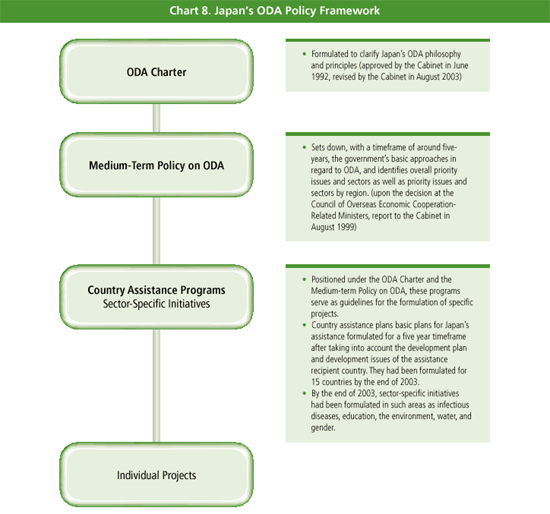 |